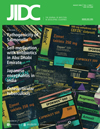Trend of Japanese encephalitis in North India: evidence from thirty-eight acute encephalitis cases and appraisal of niceties
DOI:
https://doi.org/10.3855/jidc.470Keywords:
encephalitis, Japanese encephalitis, virus, outbreak, seasonal incidence, Uttar Pradesh, India, trendAbstract
Background: In the year 2005, an epidemic of Japanese encephalitis (JE) occurred in the northern states of India. The present study was planned to reconfirm the circulation of JE in the area and to assess the trend of the disease to slow down the burden of JE. Methodology: Surveillance was conducted to identify patients with acute encephalitis. Blood and cerebrospinal fluid specimens from suspected cases underwent pathological, serological, and demographic investigations. Viral testing for evidence of Japanese encephalitis virus (JEV) infection was also performed, either by IgM capture ELISA/RT-PCR or both. To identify circulating JEV strains, RT-PCR, sequencing and phylogenetic analysis was performed. Based on clinical cases reported between 1992 and 2008, the trend of JE infection in the state was analyzed to examine the dynamics of infection. Results: Our investigations (n = 38) revealed that only 55.3% cases were positive for JE. Pathological examination revealed marked pleocytosis in CSF (90±76.9 cells/mm3), and peripheral leucocytosis (64.7±8.86% neutrophils) with mild anemia. Males were more susceptible than females with a ratio of 1.63:1 and significant gender difference (P<0.05) was observed in patients below six years. In the patient group younger than six years, the rate of infection per million was six-fold higher (P<0.005) in males as compared to females. Our phylogenetic study suggests that the circulating strain during the 2005 JE epidemic was close to GP78, and in the future a larger epidemic may occur. Conclusions: The 2005 JE epidemic was possibly caused by JEV GP78 and it is spreading into newer areas. The trend of JE suggests that the problem in North India is escalating and larger epidemics may occur in the future; therefore, serious steps are necessary to combat JE, including the development of more efficient surveillance methods and differential diagnosis.Downloads
Published
2009-08-30
How to Cite
1.
Saxena SK, Mishra N, Saxena R, Singh M, Mathur A (2009) Trend of Japanese encephalitis in North India: evidence from thirty-eight acute encephalitis cases and appraisal of niceties. J Infect Dev Ctries 3:517–530. doi: 10.3855/jidc.470
Issue
Section
Original Articles
License
Authors who publish with this journal agree to the following terms:
- Authors retain copyright and grant the journal right of first publication with the work simultaneously licensed under a Creative Commons Attribution License that allows others to share the work with an acknowledgement of the work's authorship and initial publication in this journal.
- Authors are able to enter into separate, additional contractual arrangements for the non-exclusive distribution of the journal's published version of the work (e.g., post it to an institutional repository or publish it in a book), with an acknowledgement of its initial publication in this journal.
- Authors are permitted and encouraged to post their work online (e.g., in institutional repositories or on their website) prior to and during the submission process, as it can lead to productive exchanges, as well as earlier and greater citation of published work (See The Effect of Open Access).








